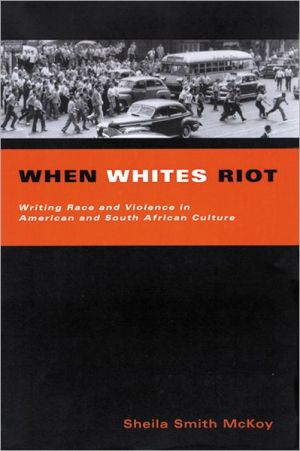When Whites Riot: Writing Race and Violence in American and South African Cultures
In a bold work that cuts across racial, ethnic, cultural, and national boundaries, Sheila Smith McKoy reveals how race colors the idea of violence in the United States and in South Africa—two countries inevitably and inextricably linked by the central role of skin color in personal and national identity.\ Although race riots are usually seen as black events in both the United States and South Africa, they have played a significant role in shaping the concept of whiteness...
Search in google:
In a bold work that cuts across racial, ethnic, cultural, and national boundaries, Sheila Smith McKoy reveals how race colors the idea of violence in the United States and in South Africa—two countries inevitably and inextricably linked by the central role of skin color in personal and national identity. Although race riots are usually seen as black events in both the United States and South Africa, they have played a significant role in shaping the concept of whiteness and white power in both nations. This emerges clearly from Smith McKoy's examination of four riots that demonstrate the relationship between the two nations and the apartheid practices that have historically defined them: North Carolina's Wilmington Race Riot of 1898; the Soweto Uprising of 1976; the Los Angeles Rebellion in 1992; and the pre-election riot in Mmabatho, Bhoputhatswana in 1994. Pursuing these events through narratives, media reports, and film, Smith McKoy shows how white racial violence has been disguised by race riots in the political and power structures of both the United States and South Africa. The first transnational study to probe the abiding inclination to "blacken" riots, When Whites Riot unravels the connection between racial violence—both the white and the "raced"—in the United States and South Africa, as well as the social dynamics that this connection sustains. Publishers Weekly Challenging the perceptions that "race riots" in the U.S. and South Africa are always perpetrated by people of color, Sheila Smith McKoy, an assistant professor of English at Vanderbilt University, explores the history of some of the two countries' most violent moments in When Whites Riot: Writing Race and Violence in American and South African Culture. Focusing on events like Wilmington N.C.'s race riot in 1898 and Mmabatho, Bhoputhatswana's 1994 pre-election riot, McKoy explores in various media the way public attention gets diverted from white violence. Several participants in the Soweto Uprising, for instance, describe how a peaceful protest by black school children one afternoon became a violent three-day rebellion after the police fired upon the crowd. While media in South Africa and elsewhere alleged that the police were provoked by the crowd's violence, McKoy contends that, in fact, the white police rioted, spurring the community to throw rocks and burn buildings. Her unflinching look at horrifying events offers an important take on race-based violence. 12 b & w photos. (Dec.) Copyright 2001 Cahners Business Information.
IllustrationsAcknowledgmentsIntroduction: White Riot - Binding American and South African Cultures31Riot-Making: Ululation, Resistance, and Reclamation112Reading the Riot Act: The Teleology of Charles Chesnutt's The Marrow of Tradition and the Wilmington Race Riot of 1898313Rioting in a State of Siege: The Cultural Contexts of Sipho Sepamla's A Ride on the Whirlwind and the Soweto Uprising of 1976714Subverting the Silences: Historicizing White Riot in Fiction and Film93Epilogue: The Tie That Binds - Los Angeles and Mmabatho, White Riot on the Cusp of a New Millennium117Notes131Works Cited and Selected Bibliography149Filmography159Index161
\ From the Publisher"A brilliant, daring, and original work . . . forcing us to see the previously unseeable white racial violence that set the terms for black response. . . . When Whites Riot will make a singular contribution to the bitter debate about race in America and South Africa."—Michael Eric Dyson, author of I May Not Get There With You: The True Martin Luther King, Jr.\ \ \ \ \ \ Publishers WeeklyChallenging the perceptions that "race riots" in the U.S. and South Africa are always perpetrated by people of color, Sheila Smith McKoy, an assistant professor of English at Vanderbilt University, explores the history of some of the two countries' most violent moments in When Whites Riot: Writing Race and Violence in American and South African Culture. Focusing on events like Wilmington N.C.'s race riot in 1898 and Mmabatho, Bhoputhatswana's 1994 pre-election riot, McKoy explores in various media the way public attention gets diverted from white violence. Several participants in the Soweto Uprising, for instance, describe how a peaceful protest by black school children one afternoon became a violent three-day rebellion after the police fired upon the crowd. While media in South Africa and elsewhere alleged that the police were provoked by the crowd's violence, McKoy contends that, in fact, the white police rioted, spurring the community to throw rocks and burn buildings. Her unflinching look at horrifying events offers an important take on race-based violence. 12 b & w photos. (Dec.) Copyright 2001 Cahners Business Information.\ \








